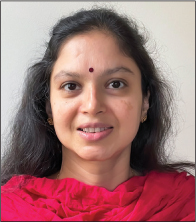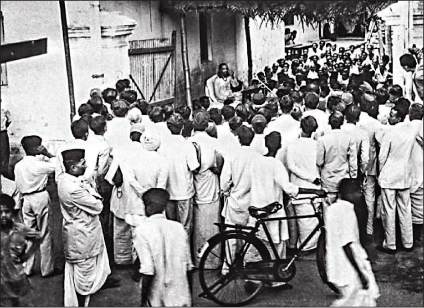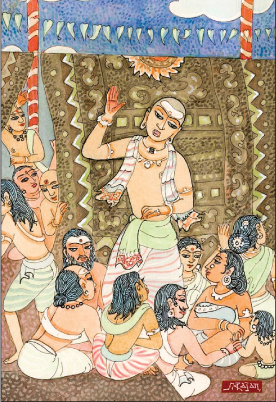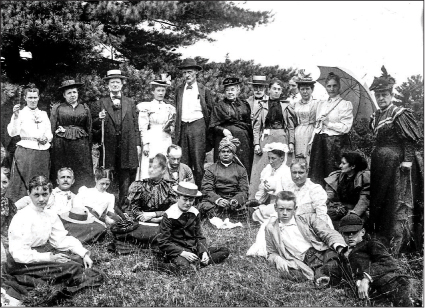Finally, I had a place to ask questions and get lucid and authoritative answers on theology, practices and issues that puzzled me from childhood
By Kumudha Venkatesan

When Lord Rama sent his pregnant wife Sita to the forest, I was filled with sorrow and started to hate Lord Rama! My curious young mind was hurt seeing Sita in dense forest. I disliked Lord Krishna when I read that He had 16,000 wives. I felt weird when my grandma performed elaborate puja and fasted on Mondays. Vedic chanting and elaborate worship rituals in the nearby temple annoyed me. My loving father—an engineer—would tell me about the glories of the Bhagavad Gita and Lord Krishna, but even he did not know the profound reasons behind ancient stories and rituals!
Growing up in Bengaluru, I occasionally prayed at home and accompanied my parents to temples on festivals, just to please them. In my school—a Christian Catholic school—we started our daily studies after reciting the popular prayer, “Our Father.” I used to envy my Christian and Muslim friends, as they had their Bible and Koran to guide them. What about Hindus? I was confused by Hinduism’s many ancient scriptures and Deities. Questions flooded my mind. Which holy book do we consider as sacred? Why do we have so many Deities? I had blind faith in God, but was overwhelmed with everything from the countless Deities to the temple rituals to animal sacrifice to mantra recitation. In short, my mind was consumed with numerous questions without logical and convincing answers, leaving me bewildered and sometimes disgusted with my religion.
As an adult, my marriage ceremony was a nightmare, brimming with rituals. I just smiled throughout to please my parents, future husband, in-laws and relatives! When I moved to the United States after my marriage, my husband and I would go to temples on festival days. When we discussed God, religions, philosophies or traditions, he often told me that he was influenced by Tirukural. When I saw the fire worship or bathing of the Deities in the suburban Detroit Hindu temples, I wondered why so many intelligent folks were interested in watching time-consuming rituals. I only saw a huge loss of manpower in these elaborate rituals! I even became annoyed when I heard any new Hindu temple was being built in the United States. At home, I mechanically performed simple puja in the mornings. Even as a adult, I was beleaguered with countless questions regarding my religion.


Everything changed when I gave birth to my son. When he was nearly a year old, my mother-in-law joined us in Detroit. We started going to temples almost every week, and slowly I was introduced to satsang—literally, “spiritual gatherings.” Swami Tejomayananda explains them thusly: “Satsang is association with goodness, nobility, truth and reality. Watching and listening to video and audio cassettes of great people is also satsang.” At first, I was shocked to see hundreds of folks attentively listening to enlightening talks on the Ramayana, Mahabharatha, Tirukural, Bhagavad Gita and Puranas in the temple.
During this phase, I also started reading Hinduism Today magazine, which dispelled many myths and illusions regarding Hinduism. The satsang was captivating, and I enjoyed the way enlightened souls, swamis and gurus explained the profound scriptures and connected their ancient wisdom to modern living. Fortunately, going to satsang helped me understand everything from the rituals and chanting mantras to the importance of numerous Deities and the power of prayer.
As I finally found convincing and logical answers for all my questions, I felt like a kid in a candy store. Satsang not only gave me answers to why Lord Rama sent Sita to the forest, and why Lord Krishna had many wives, but it immensely helped me to “connect the dots” in my life. Satsang showed me there is something very precious and eternal beyond the material world. Attending satsang gave me immense happiness and ignited good vibes in me. The late Dr. Bannanje Govindacharya’s words have deeply influenced me: “According to Agni Purana, all human beings should grow the flowers of ahimsa, love for all creatures, self-control, compassion, spiritual knowledge, meditation and dharma in their heart, and should perform puja with these flowers. These flowers are very dear to God.” Every moment, I try my best to use these beautiful flowers in my thoughts and actions.
Today, I understand my eternal religion. I enjoy my spiritual journey now, because of the spiritual knowledge that has come from satsang. Tulasidas in Ramacharitamanas says, “Without satsang, we do not get viveka, the wisdom to discriminate and understand what is right and what is wrong.” Each morning as I tackle my daily duties and challenges, the words of Swami Vivekananda flash through my mind: “The world is a great gymnasium where we come to make ourselves strong.” When problems greet me, I try to remember the profound concept of karma and my final goal of moksha, liberation from rebirth. Magically, I get immense strength and comfort, and can resolve my problem. I have noticed that my instances of anger, ego, impatience or jealousy have been greatly reduced after many satsangs. For years, I used to feel so jealous that I was not good at painting or singing. Now, I’m happy seeing successful and talented people, and I’m compassionate and kind to everyone.
I wondered why I didn’t get an opportunity to attend satsang when I was young. But I smile when the concept of karma comes to mind. I realize that everything in the universe is the divine play of God. I have understood that each person is bestowed with unique talents and virtues depending on their nature, previous births and karma. I wholeheartedly agree with Swami Vivekananda’s teaching, “Spiritual knowledge is the only thing that can destroy our miseries forever. Any other knowledge satisfies wants only for a time.”
Eternal concepts such as karma, the soul, acceptance and tolerance are explained wonderfully in our scriptures. Today, Self-Realized saints and gurus lucidly explain these concepts in temple gatherings, on CDs and YouTube. According to the Vedas, sravanam (hearing), mananam (reflection and contemplation), and nididhyasanam (meditation) on truth is the way to achieve true knowledge. Satsang is an amazing opportunity to hear and reflect on eternal truth. From this study of all the philosophies of Hinduism, I’m understanding how to increase my bhakti, love of God.

Attending satsang regularly encourages me to follow a sattvic lifestyle, performing my duties with dedication, talking only when necessary, doing nama japa, meditating, minimizing oily and junk food, singing devotional songs and reflecting on scriptures. Sometimes, when I’m constantly thinking about an important issue, I forget about God for many days. Then, after listening to empowering videos such as “Power of Nama Japa” (youtu.be/wwMfkVcWK9Q) by Swami Mangalanathananda of the Ramakrisha Mission, I feel so good. Bhakti is again ignited in me. As I start to chant the name of God, I can feel that my mind is purified and I’m in a state of joy. Sarada Devi said, “Mantra purifies the body. Man becomes purified by repeating God’s name. So repeat His name always.” Past sins can be counteracted by japa and meditation. Now, I understand why many Hindus name their kids Ganesh, Murugan and Krishna!
I have realized that the purpose of everything from rituals to prayers and religious customs to philosophies is to reach the omnipresent God. Swami Vivekananda’s words resonate in my mind, “I’m proud to belong to a religion which has taught the world tolerance and universal acceptance.” I have realized that God is beyond rituals, race and religion. I understand why Hinduism is known as Sanatana Dharma. Satsang rejuvenates my mind and reduces my worldly desires. I feel composed and calm, even during these uncertain times. I still have a long way to attain liberation, but I’m thrilled to have satsang, saints and gurus to motivate and inspire me to follow the path of dharma and perform my duties to the best of my ability. I’m eternally grateful for satsang. I feel blessed to listen to Swami Vivekananda, Swami Chinmayananda, Bannanje Govindacharya, Sri Sri Ravi Shankar and others, for helping me understand the path to “True Knowledge” which is permanent. I wholeheartedly agree when Swami Tejomayananda says, “Satsang is the greatest blessing. Do not wait for any greater grace from the Lord.”
Kumudha Venkatesan, based in Atlanta, Georgia, is a wife and mother to a preteen son. She is passionate about environment, healthy lifestyle, spirituality and loves to read and contemplate Hinduism. Contact: kumudha_1998@yahoo.com

Very well written,reflects the thoughts of many Hindus…..kudos to the writer for being so humble